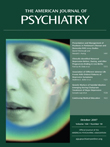In This Issue
Maternal Depression Before, During, and After Pregnancy
More than half of women in an HMO who developed postpartum depression had also been depressed during pregnancy or in the 9 months before pregnancy. A prospective study of 4,400 women by Dietz et al. (p. Original article: 1515 ) also demonstrated that more than half of those who were depressed before pregnancy were also identified with depression while pregnant. The rates of depression were 9%, 7%, and 10% before, during, and after pregnancy. Most depressed women received treatment, but during pregnancy only two-thirds took antidepressants and the proportion who received psychosocial treatment did not rise. White race, being unmarried, already having three or more children, receiving Medicaid, and smoking were associated with depression, but none was a strong risk factor. Dr. Kimberly Yonkers reviews research on maternal depression and its treatment in an editorial on p. Original article: 1457 .

Genetic/Environmental Components of Suicide and Depression
Two of 768 genetic markers tested in 1,915 depressed patients taking citalopram were associated with the emergence of suicidal thoughts during treatment. The markers are in the genes GRIA3 and GRIK2, which both encode glutamate receptors. Of the two patients who attempted suicide in the study, one has provided a DNA sample and it contained the high-risk alleles for both genes. Laje et al. (p. Original article: 1530 ) point out that glutamate neurotransmission has previously been linked to the therapeutic response to antidepressants in prior work with this sample. Their findings come from the Sequenced Treatment Alternatives to Relieve Depression (STAR*D) study, which was sufficiently large to allow genetic analysis of treatment-emergent suicidal thoughts. Another large database, the population-based Mid-Atlantic Twin Registry, enabled Keller et al. (CME, p. Original article: 1521 ) to discover connections between specific types of life events and the particular symptoms of people who develop depression. Among 4,856 people who had depressive symptoms in the preceding year, those who had experienced the death of a loved one or a romantic breakup were more likely to feel sad, lose their appetite, and be unable to feel pleasure. Participants who had multiple depressive episodes had different symptoms during each episode, corresponding to the negative events in their lives at the time. Patients without identified adverse life events were more likely to report thoughts of self-harm, which suggests that other causes, such as the genetic predisposition described by Laje et al., might be more influential in determining suicidality. Dr. Elliot Gershon comments on these results in an editorial on p. Original article: 1460 .
Olanzapine for Adolescents With Mania
Remission of mania among adolescents with bipolar disorder was more than twice as common in those taking the antipsychotic drug olanzapine as in a placebo group. During the 3-week double-blind study of 161 patients reported by Tohen et al. (p. Original article: 1547 ), improvements in nearly all scores for symptoms, illness severity, hyperactivity-impulsivity, and aggression were significantly greater for the adolescents taking olanzapine. Adverse events in the patients taking olanzapine were significant and included greater effects on weight and prolactin than observed in adults. Dr. Jon McClellan provides perspective on this study in an editorial on p. Original article: 1462 .
Relatedness vs. Self-Definition Issues in Psychodynamic Treatment
Long-term psychodynamic inpatient treatment produces changes in disordered thinking that vary by whether the patient’s central preoccupation is interpersonal relatedness or the sense of self. Blatt et al. (p. Original article: 1561 ) describe these two configurations of psychopathology and relate them to improvements in thought disorders among 90 young adults with severe personality disorder, psychotic disorder, or depression. Midway through treatment, those with disorders involving relatedness (“anaclitic”) had an improved ability to differentiate between independent objects. Patients whose psychopathology involved self-definition (“introjective”) became less likely to confuse external and internal perceptions and to attribute arbitrary relationships to separate objects or events with spatial or temporal contiguity. This differential response demonstrates the role of the anaclitic-introjective dimension in the choice of treatment and outcome measures and verifies that the distinction is relevant to severely disturbed patients. An editorial by Dr. John Oldham appears on p. Original article: 1465 .



